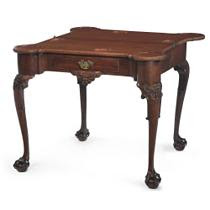Now in 2008, many auction houses, furniture dealers and consignment shops have closed their doors. It’s been bruited about by nervous dealers that antique furniture is going for a quarter of what it sold for just a year ago. Struggling dealers, as well as collectors, are busy liquidating their collections. What is going on?
 After 36 years Red Baron’s Antiques will host its very last auction this weekend --
After 36 years Red Baron’s Antiques will host its very last auction this weekend --
September 27 and 28, in Atlanta, Georgia.
The uncertainty of the economic situation in the US is certainly to blame. Another factor is the huge increase in merchandise readily available to collectors via the internet, which has threatened and continues to threaten the livelihood of the traditional middleman. Who needs an informed agent or an advisor when sellers are able to directly deal with customers all over the world?
In the past, increased competition between buyers for the shrinking market of available high-end pieces has driven the price of these items way up. However, this year even the top auctioneers have experienced disappointing results; competition for the few remaining quality pieces has become fierce. In the meantime, prices at the moderate level of the antiques market have remained static and not moving. Until recently a few bold collectors were still willing to pay relatively high prices for hard-to-find items. Eighteenth century English pieces in exceptional condition are still thriving. Whatever, the market continues to soften.
 In April Sotheby’s estimated this rare Irish mahogany card table c. 1750 to reach anywhere between $40,000 - $60,000. The hammer price (including buyer’s premium was only $37,000.)
In April Sotheby’s estimated this rare Irish mahogany card table c. 1750 to reach anywhere between $40,000 - $60,000. The hammer price (including buyer’s premium was only $37,000.)
Compounding all this is the fact that the world of antiques and decorative arts has been undergoing a fundamental change during this decade. People don’t want the traditional stuff anymore. Contemporary is rapidly becoming the most sought-after. Open any interior design magazine and you’ll find an eclectic array of mid-century modern pieces. 1stdibs has become the important internet venue which showcases almost exclusively 20th century pieces. Regional art fairs have accelerated the interest in contemporary and decorative arts.
 Eccentric Italian designer Carlo Mollino’s oak and glass table from 1949 sold for $3.8 million at Christie's New York in 2005. It was was estimated to fetch a mere $150,000 to $200,000.
Eccentric Italian designer Carlo Mollino’s oak and glass table from 1949 sold for $3.8 million at Christie's New York in 2005. It was was estimated to fetch a mere $150,000 to $200,000.
A shaky economy, now downright perilous, is not good for the auction houses and retail dealers. Everyone, understandably, seems to be walking on eggshells. Despite these fluctuations, quality pieces remain quality, seemingly in defiance of the vicissitudes of the market. If there is one constant in this madhouse it’s that really good quality pieces manage to maintain their inherent value. Markets may be cyclical, but top-quality antique furniture will always retain its special value.